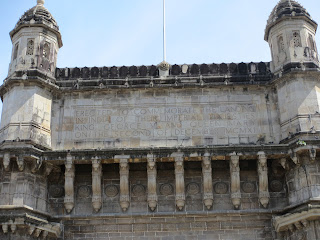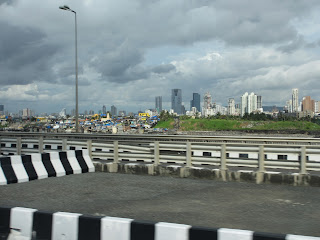The view from the hotel window
Hotel decor
The Mumbai Aquarium
Rules of the Garden
Birds!
Petting the topiary deer
Some of the sculptures of the gardens
Some informational bits about the garden:
The Hanging Gardens, in Mumbai, also known as abhinav Gardens, are terraced gardens perched at the top of Malabar Hill, on its western side, just opposite the Kamala Nehru Park. They provide sunset views over the Arabian Sea and feature numerous hedges carved into the shapes of animals. The park was laid out in 1881 by Ulhas Ghapokar over Bombay's main reservoir, some say to cover the water from the potentially contaminating activity of the nearby Towers of Silence. When seen from the air, the walkway inside the park (Hanging Gardens Path), spell out the letters PMG(Pherozeshah Mehta Gardens) in cursive.
Mrs. Peahen
Kiwis!
not sure what this sculpture is or why it is there, but I like it
The Mumbai laundry.
There are rows of open-air concrete wash pens, each fitted with its own flogging stone. Called the world's largest outdoor laundry, Dhobi Ghat is a very popular attraction among foreign tourists.The word Dhobi Ghat is used all over India to refer to any place where many washers are present.
It is located next to Mahalaxmi railway station on the Western Railway's Saat Rasta roundabout. It can be easily seen from flyover bridge of Mahalaxmi station
In 2013, World Records India and World Amazing Records honoured World Record Certificate to Dhobi Kalyan & Audhyogik Vikas Co – op. Society Ltd
I know I would not trust these cages on the side of the building.
The cows of Mumbai
Gandhi's house. Mark got some good photos inside.
Informational bit:
Mani Bhavan was Gandhi's Mumbai headquarters for about 17 years, from 1917 to 1934. It was from Mani Bhavan that Gandhi initiated the Non-Cooperation, Satyagraha, Swadeshi, Khadi and Khilafat Movements. Gandhi's association with the charkha began in 1917, while he was staying at Mani Bhavan. Mani Bhavan is also closely associated with Gandhi's involvement in the Home Rule Movement, as well as his decision to abstain from drinking cow's milk in order to protest the cruel and inhuman practice of phookan meted out to milch cattle common during that period.
In 1955, the building was taken over by the Gandhi Smarak Nidhi in order to maintain it as a memorial to Gandhi
One of the rooms
Dioramas. Lon would have loved these!
Kids dressed up for a play about the various stages of Gandhi's life. The girl was his sister or his wife, I am not sure which.
In the city of Mumbai there is a Dairy. An indoor dairy.
a lunch cart
It looked good
Victoria Station
The informational bit was in the last post
Your guess is as good as mine
Part of the Taj Mahal Palace Hotel.
Informational bit:
The Taj Mahal Palace Hotel is a "Heritage Grand" class five-star hotel in the Colaba region of Mumbai, Maharashtra, India, next to the Gateway of India. Historically it was known as the "Taj Mahal Hotel" or the "Taj Palace Hotel". or simply "the Taj".
The hotel's original building was commissioned by Tata and first opened its doors to guests on 16 December 1903.
It is widely believed that Jamsetji Tata decided to build the hotel after he was refused entry to one of the city's grand hotels of the time, Watson's Hotel, as it was restricted to "whites only". However, this story has been challenged by some commentators that suggest that Tata was unlikely to have been concerned with 'revenge' against his British adversaries. Instead, they suggest that the Taj was built at the urging of editor of The Times of India who felt a hotel "worthy of Bombay" was needed.
The original Indian architects were Sitaram Khanderao Vaidya and D. N. Mirza, and the project was completed by an English engineer, W. A. Chambers. The builder was Khansaheb Sorabji Ruttonji Contractor who also designed and built its famous central floating staircase. The cost of construction was £250,000 (£127 million in 2008 prices).
Originally the main entrance was on the other side, where now the pool exists, and the ocean was at the back, although it is now always viewed and photographed from the ocean side.
Between 1915 and 1919, work proceeded at Apollo Bundar to reclaim the land behind the hotel where the Gateway of India was built in 1924. Gateway of India soon became a major focal point in Bombay.
When it opened in 1903, the hotel was the first in India to have: electricity, American fans, German elevators, Turkish baths and English butlers. Later it also had the city’s first licensed bar, India’s first all-day restaurant, and the India’s first discotheque, Blow Up. Initially in 1903, it charged Rs 13 for rooms with fans and attached bathrooms, and Rs 20 with full board.
During World War I the hotel was converted into a hospital with 600 beds.
Jinnah's estranged wife Ratanbai Petit lived here during her last days in 1929 (her mother belonged to the Tata family). By 1966, the building was run-down, perhaps as a results of losing the British customers in 1948.
The hotel received extensive international exposure in 2008 and reopened after extensive repairs.
A statue of a horse.
After lunch there was a fun market set up. I bought a pen and ink drawing.
Gateway to India
Informational Bit:
The Gateway of India was built to commemorate the visit of King George V and Queen Mary to Mumbai, prior to the Delhi Durbar in December 1911. However, they only got to see a cardboard model of the monument, since the construction did not begin till 1915.The foundation stone was laid on March 31, 1913 by the governor of Bombay, Sir George Sydenham Clarke with the final design of George Wittet sanctioned on March 31, 1914.
The land on which the Gateway was built on was previously a crude jetty, used by the fishing community which was later renovated and used as a landing place for British governors and other prominent people. In earlier times, it would have been the first structure that visitors arriving by boat in Mumbai would have seen.
Between 1915 and 1919, work proceeded at Apollo Bundar (Port) to reclaim the land on which the gateway and the new sea wall would be built. The foundations were completed in 1920 and construction was finished in 1924.The gateway was opened on December 4, 1924 by the Viceroy, the Earl of Reading.
The last British troops to leave India following the country's independence, the First Battalion of the Somerset Light Infantry, passed through the Gateway on their way out in a ceremony on February 28, 1948, signalling the end of British rule.
Pigeons being fed
This is a statue of Swami Vivekananda!
Informational bit about him
Swami Vivekananda (Bengali: [ʃami bibekanɔnd̪o] 12 January 1863 – 4 July 1902), born Narendranath Datta (Bengali: [nɔrend̪ronat̪ʰ d̪ɔt̪o]), was an Indian Hindu monk, a chief disciple of the 19th-century Indian mystic Ramakrishna. He was a key figure in the introduction of the Indian philosophies of Vedanta and Yoga to the Western world and is credited with raising interfaith awareness, bringing Hinduism to the status of a major world religion during the late 19th century. He was a major force in the revival of Hinduism in India, and contributed to the concept of nationalism in colonial India. Vivekananda founded the Ramakrishna Math and the Ramakrishna Mission. He is perhaps best known for his speech which began, "Sisters and brothers of America ...," in which he introduced Hinduism at the Parliament of the World's Religions in Chicago in 1893.
Born into an aristocratic Bengali family of Calcutta, Vivekananda was inclined towards spirituality. He was influenced by his Guru, Ramakrishna Deva, from whom he learnt that all living beings were an embodiment of the divine self; therefore, service to God could be rendered by service to mankind. After Ramakrishna's death, Vivekananda toured the Indian subcontinent extensively and acquired first-hand knowledge of the conditions prevailing in British India. He later travelled to the United States, representing India at the 1893 Parliament of the World Religions. Vivekananda conducted hundreds of public and private lectures and classes, disseminating tenets of Hindu philosophy in the United States, England and Europe. In India, Vivekananda is regarded as a patriotic saint and his birthday is celebrated there as National Youth Day.
Mumbai has a lot of American fast food places !
India has the best worded traffic signs
Leaving downtown Mumbai for the airport
Good bye, Mumbai, wish we could have stayed longer.

























































No comments:
Post a Comment